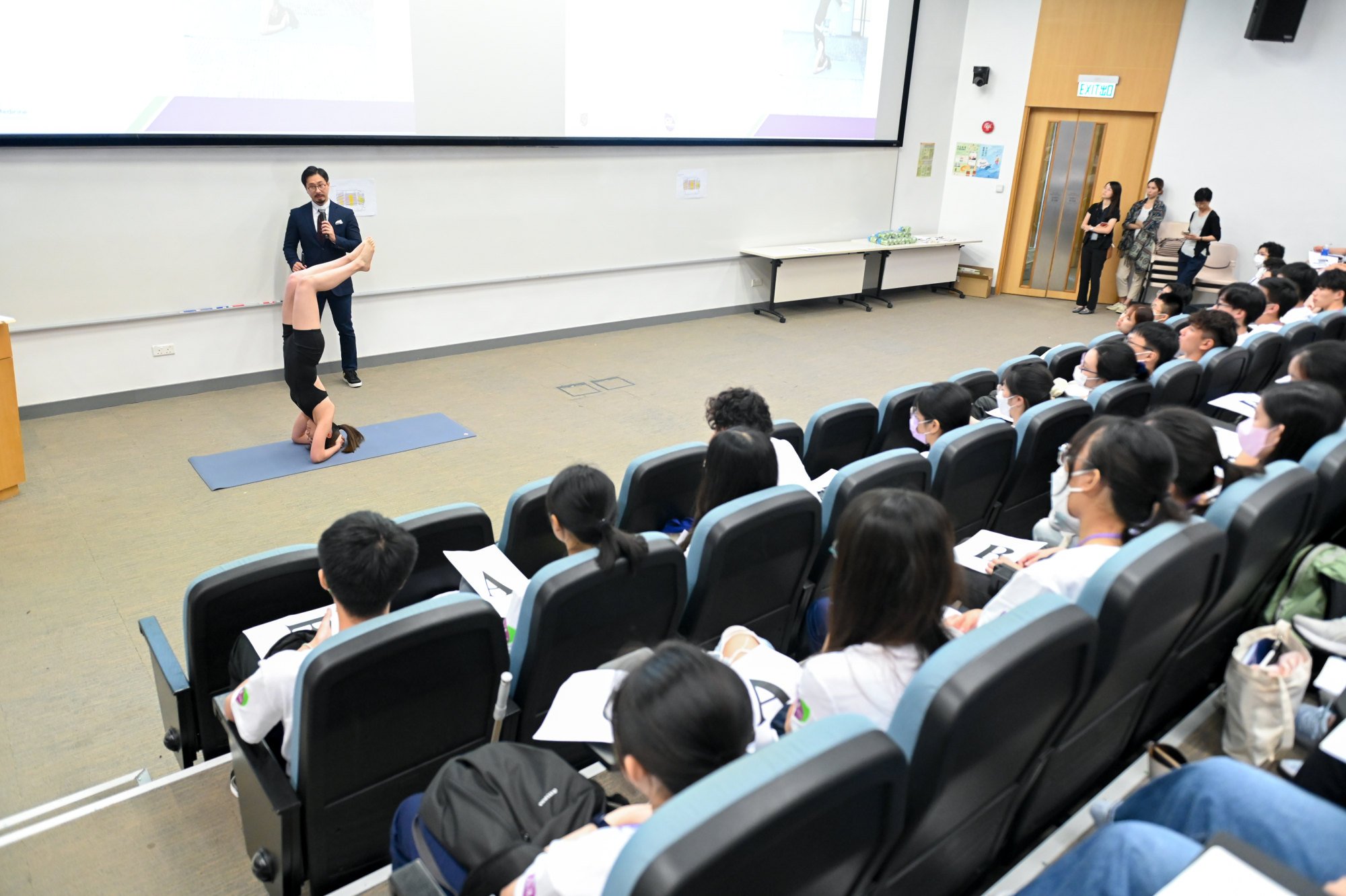
‘We’re not just show and tell’: how yoga keeps anatomy students’ attention during lectures at university in Hong Kong
- Dr Christopher See, of Chinese University of Hong Kong, uses a novel approach to highlight the workings of the human body in anatomy lectures: a live yoga model
- Junior research assistant Charlotte Lin holds yoga poses to illustrate See’s lessons, and both say their method helps keep students engaged
Dr Christopher See Yew-hong stands at the front of a lecture hall in the Chinese University of Hong Kong’s CM Li Building for Basic Medical Science.
On stage with him, junior research assistant Charlotte Lin Tien-lan holds a back-bending wheel pose – also known as upward facing bow – on a yoga mat, as 170 students look on.
See asks the class a question: which spinal curvature undergoes the most change from normal in the wheel pose, cervical, thoracic or lumbar?
After some discussion, most students raise a card to indicate the thoracic. They are correct.

See has always loved puzzles, from board games to video games.
“I’ve always wondered how I could remember information about a game without trying to learn it,” See says. “And I wondered if I could give this feeling to the students.”
Everything you need to know about yoga, and which style suits your needs
A 39-year-old father of two, See has taught human anatomy as part of CUHK’s medical faculty for three years, and is passionate about educational innovation.
His teaching often focuses on interactive task design. For example, a recent project had students solving puzzles related to brain anatomy so they could get out of an escape room.
“I don’t want to just plug in some information,” See says. “It’s much more about getting them to do a task.”
He started working with Lin in March this year, using yoga to present ideas on anatomy.

“I realised that yoga isn’t about doing the poses perfectly. It’s actually teaching you to have this mindset of acceptance of your mind and body, and being content with it,” says Lin.
She picked up the practice during her gap year after graduating from Sha Tin College in Hong Kong in 2022. Her yoga and fitness account, @move_with_charlotte, has more than 1,000 followers on Instagram.
“Yoga and anatomy are pretty much linked together, right?” Lin says. “Anatomy – teaching and learning in the classroom – gives you the physical aspect, and yoga and mindful movement lets you transcend the anatomical structure of the bones and the body.”
The class, called “Flipped Classroom: An Interactive Journey Through the Anatomy of the Spinal Column”, is part of CUHK’s summer clinical attachment programme, for prospective students currently in secondary school.

During the 90-minute class, See teaches students the intricacies of spinal anatomy, highlighting features through yoga movements, demonstrated by Lin and paired with slides. Students can identify the various zones of the vertebrae on a diagram, as well as a live human.
See occasionally quizzes the class, having students solve problems together before coming up with an answer. Students ultimately use what they’ve learned to solve a real clinical case of a South Korean man who was shot in the spine.
“The baseline of factual information is consistent across regular and innovative teaching, and I think that’s very important,” he says. “We don’t dilute any of the content. We’re not just doing a show and tell – we’re making students do a critical appraisal and approach content from a different angle.”
See says students remained engaged for the entire class, more than they do during his traditional lectures.

“The programme was nothing short of fantastic,” says Jeffrey Chan, a sixth form student from Brighton College in the UK. “This interactive style is one of the most effective ways of teaching students, no matter the audience size.”
Having Lin demonstrate yoga poses helped Chan learn specific terminology and visually recall spinal movements.
Another student – Astrid Miu Ri-zhen, 16, from Wycombe Abbey School in Hong Kong – says that even now, she can recite terminology and explain the different vertebrae structures because of the effectiveness of the class.
One student stopped by after class and asked whether British football player Raheem Sterling’s particular running style was related to lumbar lordosis, a condition See had touched on. Another asked about how to maintain stability on a wakeboard.

“It’s easy to replace a yogi with the classic skeleton you see in a science lab,” Lin adds. “But this way, people will say, ‘I’m not learning it for the sake of learning it – I’m learning about me’.”
The yoga-based anatomy class will become a permanent part of the summer programme.
Lin will begin studying medicine at CUHK in September, but she and See plan to continue working together throughout the school year to expand the yoga-anatomy class to other areas. They also hope to introduce online material.

